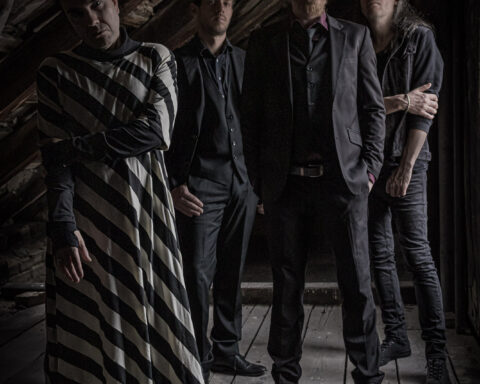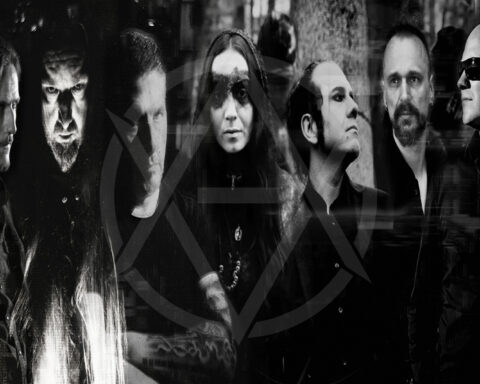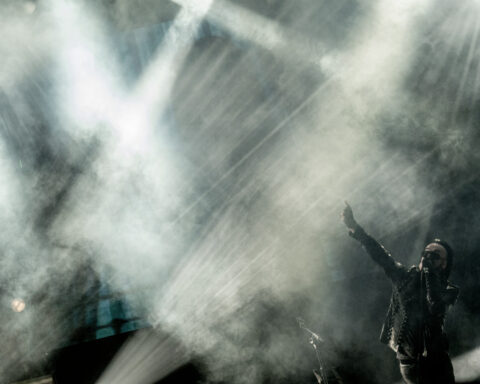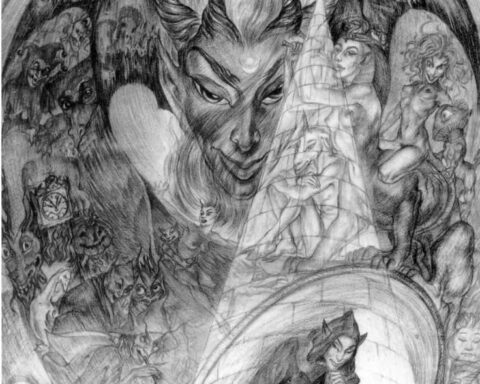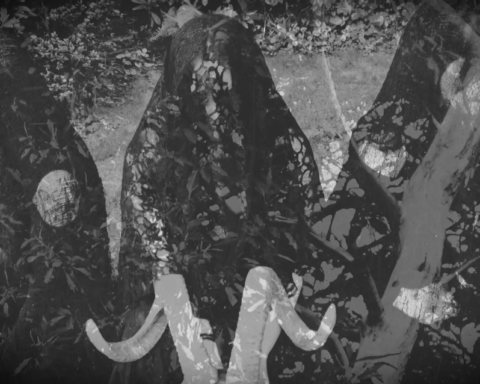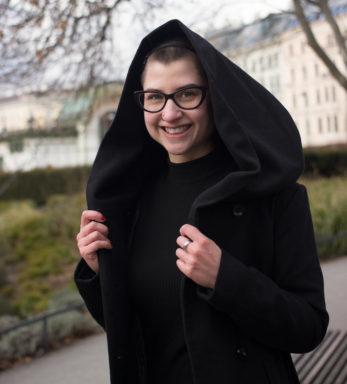I am delighted and excited: the artist Billy Phobia answers questions about his art and his view on the symbiosis between music and cover artwork. Many bands from the Solar Lodge label have been working with him for years. It’s high time to learn more about him and his art.
I know Billy Phobia for many years, since the SGM Festival in Madrid 2012, where he was the DJ and part of the organizer-team.
You are a very creative person on many levels. Music, art, design… what form of artistic expression do you prefer for your own ideas? Billy: Indeed, my joy’s soul lies in creativity. Well, I think that all of them give voice to my inner self and let me sharing it to the world in uniquely personal ways. However, only art makes me truly resonate with the thrill of the creation in itself, regardless the alleged artistic merit or the perception of the final result by others. At that very moment my senses operate at their peak and I feel fully alive. Conversely, as professional designer, I have to meet certain needs and make my ideas work. I enjoy the challenge a lot but there are many external factors affecting my expression to a lesser or greater degree, while I’m always trying to take it all to my artistic terrain. Similarly, it makes little sense to spin music at a club or curate a mix of songs without taking your audience into account at all. I’m myself on decks but also strive to find a balance between what I want to share and what circumstances require. Everyone is a DJ at home. In fact, everyone is a DJ now, but that’s another story. In short, although all these forms of artistic expression are meaningful and fulfilling, I would choose art as it’s a completely free and introspective journey without a clear fix on the destination.
For many years you have been creating cover artwork for bands from the Solar Lodge label as well. Which bands have collaborated with you so far and how many ideas have you published? Billy: It’s my great pleasure and privilege to assist bands in translating their music into images, especially when I truly support and respect them. This is the case with Sweet Ermengarde, Whispers in the Shadow, October Burns Black or The Devil & The Universe, focussing on collaborations with acts from our scene. As visual designer, I’ve also created album cover artwork, merch, websites and videos for bands of any kind. In most of these projects, I have to establish a previous feedback dialogue in order to narrow the abstract divide between the preconceived visual ideas of the artists and what their music inspires to me. All it in the light of the aesthetic and design rules, whether it be to break or respect them. So I play safe when arranging a design concept, while it’s hard to arrive ‘there’. By contrast, working together with the above-mentioned bands has been quite different. Musicians like Ashley Dayour (Whispers in the Shadow, The Devil & The Universe) or Lars Kappeler (Sweet Ermengarde) are really focused on what they want. Furthermore, they are very creative guys, each in his own way, and always have interesting ideas about the graphic representation of their music. This makes things much easier when seeking an suitable look & feel, besides the evocative power and rich imagery of the songs they write. Moreover, they are inexplicably very confident of my artistic capacities so the creative process uses to be very fluid. Rarely the originally brainstormed idea is not published in the end. Much the same could be said about my recent collaboration with October Burns Black, a project I was totally in sync with since the beginning. Overall, I’m fairly pleased with all the album cover artworks and merch designs I’ve created. I feel that everything fits when I look at them while playing the music. No better payment for me.
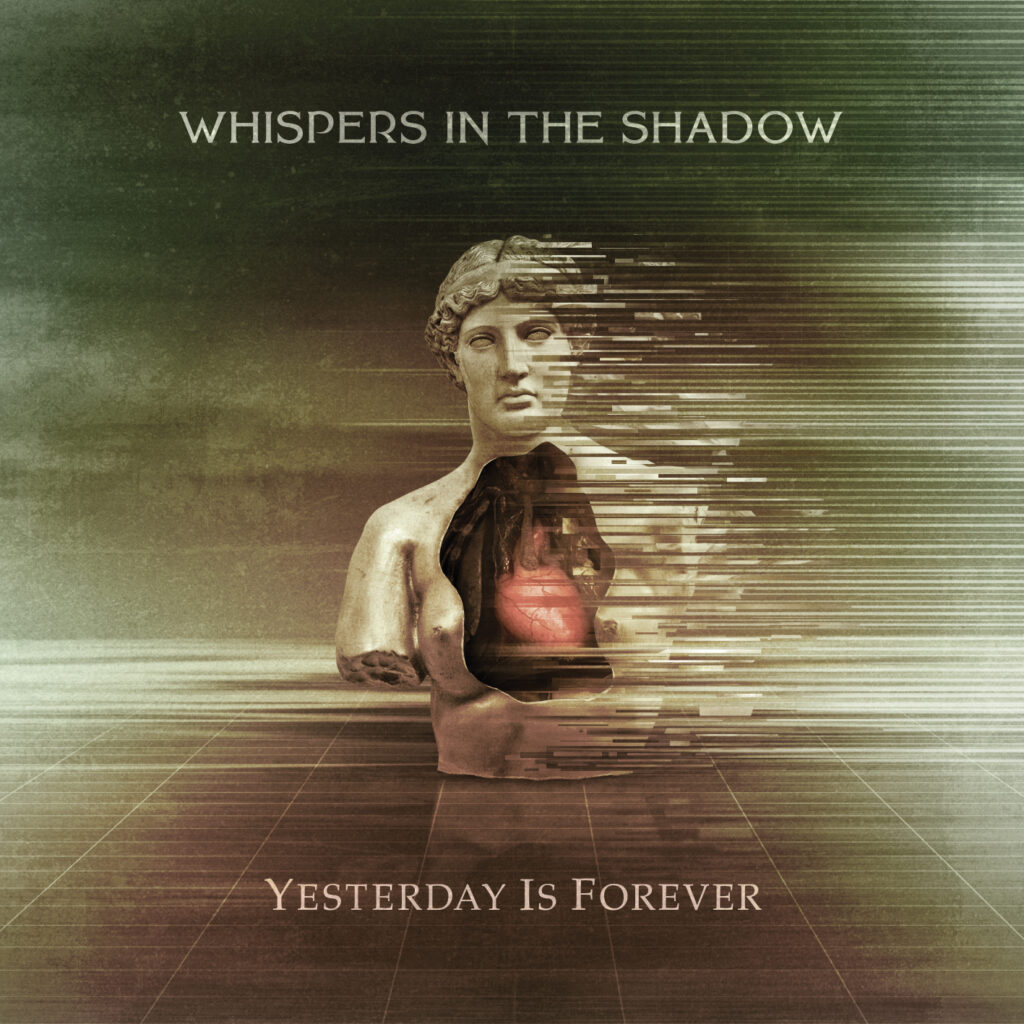
Which art period, which artists inspire you? Why? Billy: Speaking about illustration, I think my muses are as eclectic as I am. While it’s true that I have a strong predilection for dark, occult, symbolist and surrealist art. However, I don’t deliberately seek inspiration in an specific artist, style or period. I draw it from a diverse mosaic of personal experiences, feelings and circumstances. My artistic influences are also lurking in there for sure but I’m not aware of them when facing a blank digital canvas. It happens all by itself. Nevertheless, my style indirectly nourishes from the Dutch engravings of the golden age of printmaking and late 19th and early 20th centuries art movements like Nouveau, Déco or Symbolism. Particularly, I’m seduced by the decadent, weird and mystic imagery of symbolist book and magazine illustrators such as Harry Clarke, Manuel Bujados or Rafael Romero Calvet, to name just a very few. As you could see, what attracts me the most is the iconic and dynamic power of lines as the vector drawing technique I use is essentially based on connecting dot to dot until the artwork is finished. Interestingly, all these referents are linked with design and literature, what says much about me. The dystopian surrealist artworks by Zdzisław Beksiński, the “Black Paintings” by Goya, the Polish film poster movement from the ‘50s to the ‘80s… the inspirational list would be endless.
The artwork of an album is usually the first impression before listening. Besides the band’s ideas, what things have to work on you to come up with cover ideas or design ideas for merch products? Billy: Indeed, my main objective is capturing the essence of the music by using just the right combination of visuals. Above all, an album cover artwork or a merch design must work to that effect. It’s therefore crucial to listen and analyze the music in depth before and throughout the design process. The songs can change slightly or significantly during the recording sessions in the studio so better if the final mixes are provided. However, this seldom happens as it could cause an extra delay in the release of the album. In addition, not every record is conceptual and therefore what is first required is to find a visual common ground that matches at least most of the songs. To achieve this, I pay attention to the overall mood and tempo of the album tracks, as well as the imagery and metaphors addressed in the lyrics. Another important issue to bear in mind is letting the voice of the band come through, rather than my own desired aesthetic. The graphic style must resonate with the artists and their fan base. To make the album cover artwork or the merch design truly their own, it’s also helpful to know which themes to focus on and which ones to avoid. In the case of gothic rock bands, I have a certain edge in understanding that, as I’m a battle-hardened supporter and a potential consumer of the final product.
Can you come up with creative ideas even if you don’t like the band’s music or current album? Billy: Of course, I’m a professional. Even I can feel motivated because the challenge. However, connecting with the artists and their music always brings out the best of me, makes things flow in a steady and natural way and enriches my creative experience.
You live in Madrid: a beautiful, vibrant city. Do you find inspiration also on day-or night walks through this city? Billy: I love Madrid, and that’s precisely a key reason. The cultural, leisure and gastronomic possibilities offered by this city are infinite. Art and History amaze me at the turn of each corner. I’m also fascinated with its unique cobalt blue sky (the greater part of the year it’s so), especially when is dotted with those Velázquez’s pink dispersed clouds like brush strokes at dusk. Coincidentally (or not?), I just live in the same area where Goya’s stately home was located in his time. It’s known as Quinta del Sordo and he had his studio there. You can imagine what this can mean to a guy like me. Having the daily chance to witness and go through the same sceneries that the master painted during his costumbrist epoch is priceless. Furthermore, my residence is surrounded by parks and gardens, just between the Manzanares River and the Cemetery of San Isidro. It’s a great district for taking lovely, unwind night walks or finding ideal reading nooks. Moreover, I can see the southern façades of the Royal Palace and the Almudena Cathedral from the back of my building. In fact, I can reach the city’s historic centre, the Debod Temple or the Gran Via by foot in about 30 minutes. Another route I use to take, lined with zones perfect for strolling around, leads to the newly inscribed on the World Heritage List as Landscape of Light, which comprises the Prado, Reina Sofía and Thyssen-Bornemisza National Museums, as well as the Retiro Park, among many other interesting places. And so on… Thus, yes, I feel immensely lucky to walk through such incomparable and inspirational settings. It’s my favorite form of meditation and I’m a natural-born watcher so I try to cover around 10 km almost every day.
Are you a spiritual person? If so, does this find expression in your graphics/art? Billy: Not in the religious sense of the term but in our cosmic relativity and self-discovery I think I am. At least, I attempt to hold a strong connection to myself and what is around me. Since our bodies actually contain atoms that were forged in stars, we are undeniably linked to the universe. It exists to us and we must learn to live in tune with it. You know, I don’t know but I really want to know. My pending spiritual subjects are loving the human mankind and rejecting the materialistic. I swear I’m trying to work out the second. Maybe I’m just a “soulish” person. Be that as it may, I think all these thoughts find expression in my art for sure. Otherwise, it would be neither art nor mine. It’s even therapeutic for me, as it helps to relieve the stress and anxiety that some human behaviors cause to me.
What music have you listened to in the last 24 hours and what was your last live concert? Billy: Let me see… I’ve enjoyed a couple of vinyls (“The Seer” by Swans and “Svartmyrkr” by MZ.412), the “Pylon” CD by Killing Joke and the digital album version of “Two Worlds Collide” by October Burns Black. I’ve been also watching the full concert by Bauhaus at the Cruel World Fest (May 2022) via YouTube and listened to “The Buried Storm” by Darkher on Spotify (here I would call on mastering engineers to stop ruin recordings by compressing the crap out of them) and “Requiems from the Abyss” by NFD on Bandcamp. That’s it, to tell the truth. Luckily, my last live concert was Iggy Pop at the Royal Theatre of Madrid on 26 July 2022 and I’m still processing it. It was memorable.
“Art is a lie that allows us to see the truth.” (Pablo Picasso) What’s your first thoughts about this quote? Billy: I totally agree. When people lie is freer than telling the truth. Then they reveal the world as it should be, without a reality (the truth taught to us) veil in between. Almost by definition, art is a lie. It’s a metaphor of reality. The artists express their emotions, feelings and experiences through their artwork, sharing their own vision of the world they live in. That’s when the opening of the beings occurs and that other way of think comes up, allowing to see the pure truth. Picasso follows the quote with “…the artist must know the manner whereby to convince others of the truthfulness of his lies” – what is also very much applicable to design. It’s not so important how, but the message should come out loud and clear. Otherwise, that genuine truth will become into boring reality. Picasso himself expressed a similar idea in another way: “Everything you can imagine is real”. In this regard, I like this quote from Marc Chagall very much: “Art seems to me to be a state of soul more than anything else”. Amen to all that.
Lastly, please get involved with this scenario: cassettes, Vinyl, CD, Stream…and then? How about the music consume in the next 20 years? What is your personal prediction for the future? Billy: Given the accelerated times we’re living in, I think that nobody can predict with certainty what will happen in the next 20 years in general, much less with regard to the music industry. The past two decades were dominated by the shift from physical to digital – except for the resurgence of our hero the vinyl in the 2010s. Nowadays, streaming is the driving force of recorded music and the digital revenue has continued to rise thanks to it. As things stand, I think it’s easy to imagine music created and curated by algorithms taking their place over the next few years – if it’s not happening yet. Even it’s not so farfetched to expect that shortly after the smart machines will radically transform how we make, discover and interact with music. A kind of AI always-on DJ perfectly tuned with our moods and activities through some wearable brain device or microchip under the skin. Who knows? Nothing is impossible facing this period of grand evolution/involution. This scenario might seem idyllic to some. To others, it will seem oppressive, privacy-violating and bizarre. I prefer to write my own story about how I enjoy the songs that “find me” and not the other way round. It should be part of the appeal when communing with music, right? The way it’s woven into our cultural and social lives. Our most precious musical memories stem from unforgettable moments, thrilling accidents or just plain chance. That seems hard to replicate for an algorithm that only knows you through a screen. Not so much in the case of the AI, if you consent to your mind being analyzed. However, let me entrust myself to the physical format, whether it’s live music, packaging or merch, which is not so immediate and can’t be replicated online. Or can it?



